Thompson BG deal, BG SP and BZ of 1950
Three parts covering two designs by Thompson and a later one in his style:
1944 - 61'6" deal BG
1947 - 63' steel panelled BG
1950 - 32' steel-panelled Thompson-style 6w Luggage Brake Van
Short cuts now available - key section to go there directly.
1 - 61'6" Thompson deal BG
There used to be two kits of this bogie van but before I tackle one of them, here is the prototype side of the equation which will hopefully clear some errors in previous accounts and present the vehicle in a fresh light.
The prototype
To begin with it has several times been stated that this was the first Thompson-designed vehicle to be built after the War: in fact it was a creature of the War and the first one was built in December 1944. Most of the rest followed in 1945, construction ending in 1946:
1944 70584 1945 70585 - 70626 (42) 1946 70637 - 70637 (10) Total = 53
Why deal?
During the War, the LNER all but ran out of teak and, with steel being rationed, construction of the Gresley 61'6" BG, which was now being built with steel panelling, had to be fitted with marine ply instead. With the War still raging, there was a need for more BGs - not to carry passengers' luggage but as a high capacity general van. Indeed, the LNER ceased construction of carriages in 1944 and when restarted in December of that year, and through 1945, only 5% was for passengers - 95% was for BGs, and it was to the new Thompson design. They can be viewed as part of the War effort.
Faced with a shortage of material, and a need for simple construction that made minimal demand on the workforce and its size, Thompson decided to adopt practices which were long established for goods vans and NPCS. He chose to use deal, laid horizontally. At this point, a word about terminology may help because modellers have a habit of using the term "deal planking". The word "deal" specifies wooden planking of a certain size, typically pine. To say "deal planking" is like saying "wooden timber".
Other features
As is usually the case with new designs, there were precursors and a notable pair was the Southern Railway's bogie vans, a gangwayed PMV of 1928, and in 1938, a non-ganyway B with a guard's compartment. The PMVs were built with uniform width planking but in the later design, the width was variable, arguably giving a more pleasing appearance. Otherwise, both designs were cluttered with vertical and diagonal steel bracing while the doors, with steel strapping and windows, were mounted externally. All this harked back to the original SECR concept of 1917.
 .
.
A rather nice portrait of a SR van B in service, S239S at Axminster, 14.2.62. Photo: Mike King collection.
Click on the image for an enlargement
Thompson was a moderniser in many ways and the War forced him to use similar materials but his design was highly streamlined. Almost to the point of brutal simplicity, it could be said, which begs the question, was it more elegant? That's a moot question for opinions about both types are much divided! Either way, the SR may have been happy running express passenger trains with clunky-looking vans but the LNER was not and that would have influenced Thompson's design with all the bracing inside the body, flush doors, and the LNER practice of a row of toplights just under the roof. The only projection was the guard's ducket, and that was only on one side.
Other aspects of established practice on the LNER included the length of 61'6" on the steel-angle underframe and Gresley 8ft heavy bogies. The bow ends leading to the gangway, previously radiussed, were now angular. A new development was in dispensing with a domed-end roof in favour of a straight roof, a feature standardised by Thompson for all his carriages. There is a good drawing in Historic Carriage Drawings by Nick Campling, Pendragon 1997.

The first picture shows the design as originally built during the War. No 70590 was turned out in early 1945 and painted brown, with passenger-style shaded lettering and war-time "NE". Apart from the deal body, all the features were recognisably LNER with battery boxes on the side opposite the ducket. A label clip was soon added. Photo: LNER, author's collection.
Click on the image for an enlargement

D.327 in all its utilitarian glory. Note how the planks on the doors were out of sync with the body, a feature that's readily visible in the photographs below. Running on Gresley heavy 8ft bogies as normal for mid/late-LNER NPCS (not Gresley light 8'6" passenger bogies as one source would have you believe). See above for the running numbers. LNER Diagram, author's collection.
Click on the image for an enlargement

A stunning broadside view shows E70591E at Langley Junction on 4th August 1962. The condition is as-built, plus the label clip, in BR maroon livery. Photo: David Percival.
Click on the image for an enlargement

E70606E is parked at Cambridge on 6th July 1963. Most striking was the application of lining along the waist. No explanation has yet been found for this variant and this is the only known example. Photo: David Percival.
Click on the image for an enlargement

The date is 5th April 1966 and E70624E is seen on the Southern Region at Horsham. The planking on several of the doors has been replaced and there is another modification for rectangular beading has been applied on the outer corner and alongside the doors. Photo: R.S. Carpenter.
Click on the image for an enlargement

BR blue - the final picture in this section shows E70634E at Crewe in 1970. The condition is still excellent and the livery is BR Rail Blue. Not being a passenger carrying vehicle and only 24 years old, it had survived the cull of wood-panelled passenger carriages (of which the longest lived survivors were the Gresley buffet cars) and was still in service. Note the bogie van behind, a Gresley 61'6" BG with steel panelling. Photo: author's collection.
Click on the image for an enlargement
In service
After the War, Thompson designed another BG, 63' long with steel panelled sides as per his passenger carriages to run with prestigious expresses. This was D.344 and unlike the deal BG, all were placed in the ECJS fleet. The deal BGs had always been intended for less exalted, general service but they were occasionally operated with expresses, as two of the pictures show.
Most of the time, however, they were used as through vans to carry parcels-rated goods, attached to secondary expresses and Ordinary Passenger trains, and in parcels trains, of course - which became more numerous in BR days and which took them around the country. The SR adopted some for newspaper traffic where their greater capacity compared with 50ft PMVs and 51ft Van Bs was useful. The following pictures are in chronological order:

A4 No 21 Wild Swan storms out of the Gasworks Tunnel on 7th June 1947 with the 5.50pm KX-Newcastle and a Thompson D.327 BG behind the tender. Photo: ER Wethersett, author's collection.
Click on the image for an enlargement

Recently-built B1 No 1230 c1948 in LNER apple green livery is at an unknown location (near Darlington?) working an Ordinary Passenger with a non-gangwayed Thompson coach leading. Behind the tender is an LNER Special Cattle Van and a Thompson deal BG. Photo: author's collection.
Click on the image for an enlargement

A rare picture of a deal BG attached to an express passenger train on the ECML/GNML. There's motion blur on the loco, No 60110 Robert the Devil (KX) in what appears to be BR blue livery, but much of the train shows well with a full complement of destination boards. At the head is a deal BG, and behind the tender, an ex-NER strengthener. Photo: author's collection.
Click on the image for an enlargement

A view from the mid-1950s shows York's rebuilt B16/3 No 61417 at Newcastle with a Code D partly fitted Express Freight (AVB not less than one third of the train). The rear of the train comprises normal goods wagons but the head is a mixture of vanfits and bogie vans with a Thompson D.327 leading. Photo: author's collection.
Click on the image for an enlargement

In this scene around 1960 on the approach to Leeds at Osmondthorpe (later downgraded to "halt" status), York's A2 No 60522 Straight Deal has a long express passenger train made up with BR Mk.1s, the odd Gresley, and a deal BG just inside the formation. Intriguingly, it's the only picture to hand which shows the non-ducket side. The train is the 9.55am Newcastle-Leeds express with ex-LNER catering, the same formation crossing the Pennines after the ER loco came off at Leeds City. Photo: John Beaumont.
Click on the image for an enlargement

A Code C fully fitted parcels or express freight (it's hard to tell when the train is cropped like this) at Rugby Midland on 25th November 1961 headed by Willesden's ex-LMS Hughes "Crab" No 42935. Behind the tender is an ex-LNER BG to D.327. The heavy 8ft bogies show well.
The two pictures above also illustrate how, once the Thompson 63' steel-panelled BG to D.344 started being built in 1947-50 for EC express passenger service, the deal BGs were dispersed into lesser services. Photo: Author's collection.
Click on the image for an enlargement
 .
.
Another example of an unhelpfully blank-on-the-back photo shows K3 2-6-0 No 61826 with a parcels working leaving Scarborough with:
BG |
full brake |
61'6" Thompson deal |
D.327 |
vanfit |
BR? |
||
The shed plate is fuzzy but may be 41H which was Staveley 6.3.60-9.6.62. Loco then went to Colwick and withdrawal in September 1962. Best I can offer is that this was an example of short parcels working at the time. The BG looks as if it had been shopped recently and carrying BR maroon livery. I cannot identify the vanfit and notice that one of the doors is open. Photo: N.Skinner.
Click on the image for an enlargement

This view on the LMR at Basford Hall Junction (a mile or so south of Crewe) is not easy to interpret. Dated Saturday 10th May 1952 it appears to show an Up 11-coach excursion - plus two bogie vans behind the tender, which is unusual. They are:
BG' |
ex-LMS |
57' |
1920s P.1 |
BG' |
ex-LNER |
61'6" |
D.327 Thompson deal |
There were no particular sporting events that day. Loco is 45621 Northern Rhodesia (allocation not known). Photo: RW Hinton.
Click on the image for an enlargement

A scene in the deep cutting near Weybridge in 1965 shows the four tracks and a train on each one. The one to focus on has Riddles 5MT No 73170 rounding the curve with a Salisbury-Waterloo train on the tail of which two wooden-bodied bogie vans have been attached, a SR Van B of 1938 and a Thompson deal BG of 1945. Both types of Thompson BG were used in the newspaper traffic on the Southern Region. Photo: David Percival.
Click on the image for an enlargement

And finally, here's a view at Stanraer Harbour on 10th July 1969 looking across two sidings containing vans in parcels traffic. To the left is a BR GUV, and, to the right, Thompson deal BG No E70634E. By coincidence, the same vehicle is shown a year later in BR blue at Crewe (see above). The LMR seemed reluctant to let it go! Photo: author's collection.
Click on the image for an enlargement
2 - 63' Thompson steel panelled BG
In hand
3 - BR-built Thompson-style 32' 6w Luggage Brake Van
Information about this 5T van is relatively sparse and confusing. They were built by BR in 1950 at Stratford but often mis-named by writers as "ex-LNER", a "Thompson design", and "steel". The awkward truth is that in 1945 Thompson had established a new style of wooden-bodied/steel-panelled carriage that became the LNER's house style. When he retired in 1946, the new CME was Peppercorn, who retired in 1949, then J.F. Harrison who had been a student under Gresley and on nationalisation, took over as the ER Mechanical & Electrical Engineer under whom this design was produced in 1950.
So we have confusion between the engineer responsible for new designs and their construction - and continuation of house style, which was maintained on the ER for new construction during BR's first 6 years - until 1953. This luggage brake van was introduced in 1950 to the prevailing house style and built by Stratford.
A leading question is why was a 6w chassis provided? It has been seen as a follow-on of 6w van design from NER days but all the pre-Grouping companies had built them - and kept them running. Indeed, the LMS had continued in this vein with new construction of the "Stove R" from 1932-1940, building 120 altogether. There was always a use for a 32' van with a guard's position and the LMS used them for its long distance haulage of milk traffic. But the LNER and the SR had long gone over to the 4w version (the LNER's with a guard's position) and BR was eventually (in 1959) to build a guard-free 4w version as a general purpose CCT so this 6w design in 1950 begs questions that are hard to answer.
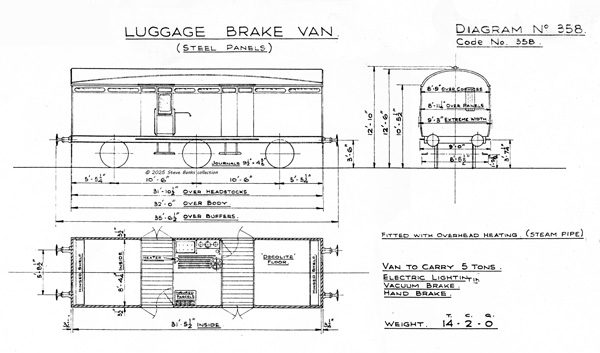
This is the Diagram, undated and without running numbers, which were 70647-70726 (=80), all built in 1950 at Stratford for the ER with an "E" prefix - but also an "E" suffix as per a pre-BR origin. The transition years from Big Four to BR saw all sorts of livery anomalies.
Note the title, a break-away from LNER practice when it would have been simply "Brake Van". The underframe was, as usual, not shown on the Diagram and was based on BR components which I comment on below. They are believed to have lasted into the 1970s, some carrying BR blue livery. The telegraphic code for all 6w vans was "BZ" (it was not a class designation). Author's collection.
Click on the image for an enlargement
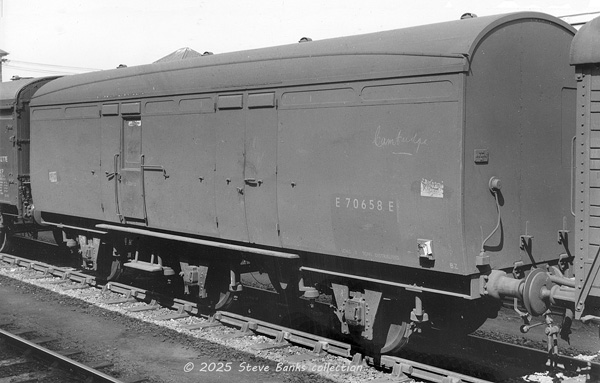
An in-service view of E70658E at Plymouth on 17th May 1959, inside what looks a typical parcels train of the time. Note the heavy duty BR axleguards and standard axleboxes with standard journals. Photo: S.V.Blencowe collection.
Click on the image for an enlargement
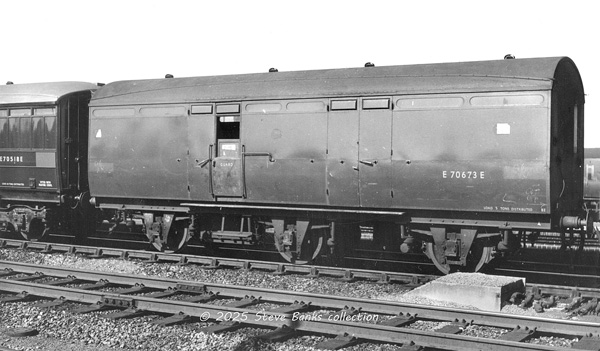
Seen on 27th September 1959 at Swindon is recently refurbished E70673E. Barely visible are the almost invisible joins between the upper and lower steel panels, which would have been welded and ground flush. Author's collection.
Click on the image for an enlargement
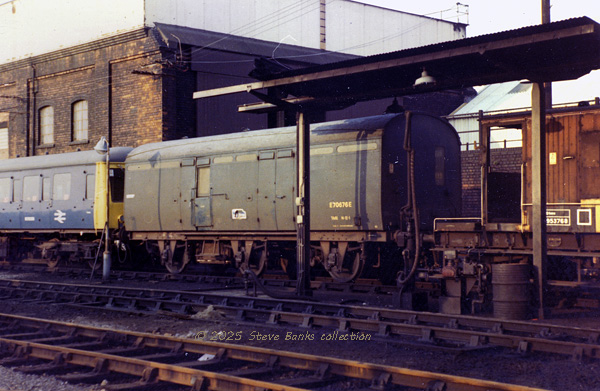
No date or location. I'm afraid, for this view although the surroundings indicate a WR location, of E70676E on an evening in BR blue. Author's collection.
Click on the image for an enlargement
How they fared
An old friend with family roots in the LNER has come forward to say that the Drawing Office at Stratford had already been closed and it is not known if the design was produced at York or Doncaster. It also turns out that construction at Stratford was by assembling parts supplied by other works (which would explain the high rate of delivery) and that there is a tale of fraud in which wood for the superstructure was not the usual hardwood but softwood stained to look like hardwood. Hence many of these vans rotted away prematurely. It seems that three were bought for preservation but only one survives today, the others simply collapsing as the rot advanced. This would explain a short service life of only about 25 years, about half of what should have been expected.
The last survivor is on the preserved GCR, No E76054E.
In service
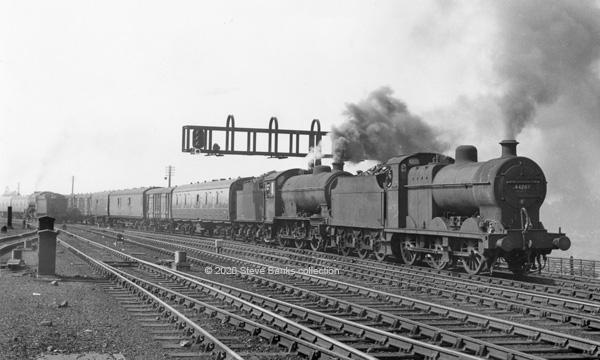
An undated picture at York has 4F 44207 (55B) and J39 (GOR) with what I suspect was the Red Bank empties, possibly in 1959. Photo: Neville Stead collection.
Stock which can be seen is:
BG |
BR Mk.1 |
PMV |
SR utility van |
CCT |
n/k - on turnbuckle trussing |
B(6w) |
BR-built Thompson style |
PMV |
SR utility van |
PMV |
SR utility van |
BG |
BR Mk.1 |
BG |
BR Mk.1 |
... rem not visible |
The unidentified bogie van has defeated me! It looks like an LNER steel-panelled conversion for carrying cars but I have yet to find the Diagram.
Click on the image for an enlargement
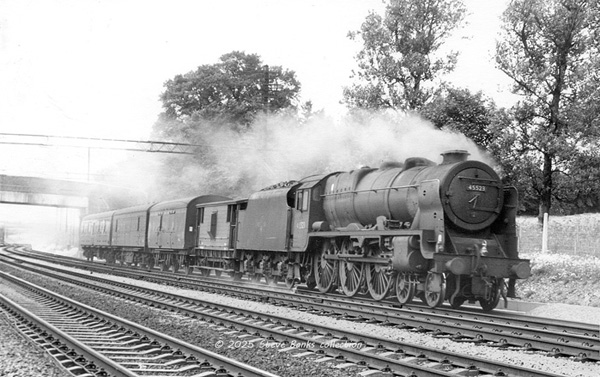
Seen at Berkhamsted on 6th August 1963 is an Up parcels and a sign of changing times, a light train and relatively modern stock with an empty goods brake van added:
GBV |
ex-LMS |
|
B(6w) |
6w Thompson style |
|
CCT |
ex-LMS |
(later reclassed GUV) |
BG |
BR Mk.1 |
|
In charge was rebuilt Patriot No 45523 Bangor. Photo: KCH Fairey.
With thanks to Mark Hambly.
Click on the image for an enlargement
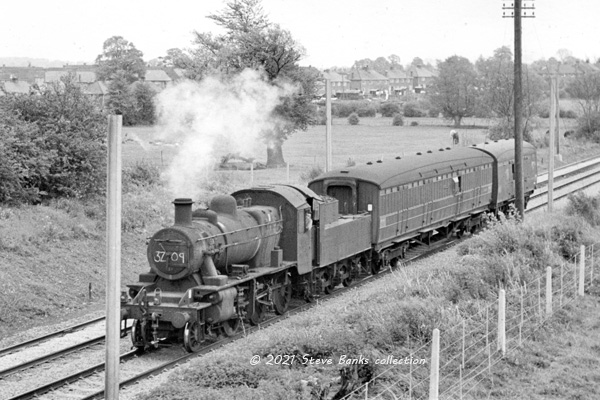
Captured in the summer of 1964 near Long Lawford and heading from Rugby to Coventry is an unidentified post-WW2 ex-LMS Ivatt 2MT 464xx 2-6-0 with a two-van parcels train:
BG |
ex-LNER |
Gresley 61'6" |
B(6w) |
6w Thompson style |
|
The photographer was hard-pressed to get a result here with the telegraph poles on this side of the track and steel posts being erected for electrification. Photo: Michael Mensing.
Click on the image for an enlargement
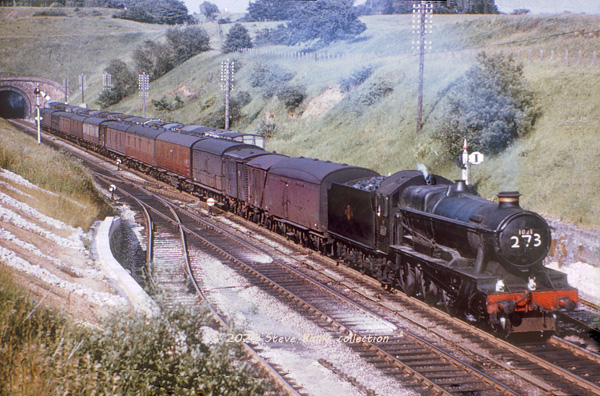
At an unknown date c1960 ex-GWR "County" Class 4-6-0 No 1021 County of Montgomery emerges from Whiteball tunnel with an Up parcels. It takes a colour view to show the enormous variety of rolling stock and liveries before eclipse by BR Mk.1 stock, in this case:
11 parcels or brake vans 3 vanfits
I'll identify as many as I can later, the important thing for now is that this train contains two ER 6w Luggage Parcels Vans, one leading the train and a second one rather faintly, third from the back. Photo: Steam & Sail 1736.
Click on the image for an enlargement
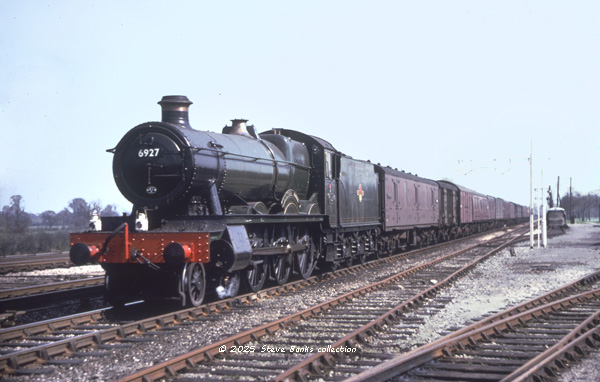
No date nor location for this photograph of No.6927 Lilford Hall (OXF) in the 1960s (this "Hall" was at Oxford from 1958 until withdrawn in1965) with a parcels train of 12 vehicles most of which are, alas, not in focus. The trend is clear, however, with only a few bogie vans (of BR Mk.1 design) and many 4w vans and Mk.1 CCTs. Probably oldest of all is the third vehicle which is a 1930s ex-LMS CCT to D1929. It was planked horizontally with four slim windows on each side and lasted into the 1970s.
The 7th van is an ER 6w Luggage Brake Van which I wasn't sure about at first and had to magnify the as-scanned TIFF image. It had been serviced recently and is carrying the BR maroon livery and grey roof. Interesting that half of the train views of this van were taken on the WR. Photograph: Keith Pirt.
Having studied the OS 25" maps on a hunch from John Suckling (thanks John) I am pretty sure that the location is approaching Tilehurst, the first station out of Reading on the line to Didcot, and by using a solar calculator, approximately 2.30pm. Now to check the WTT...
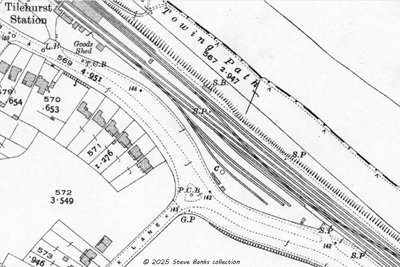
OS 25" map just south-east of Tilehurst station. Source: NLS.
Click on the image for an enlargement
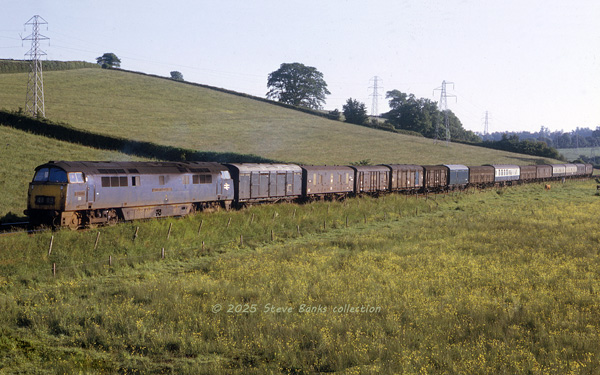
This image is dated Thursday 13th June 1974 but the location is not identified. With the sun beginning to set "Western" diesel hydraulic No D1063 Western Monitor also has 14 vans in which the 6th one is an ex-ER 6w Luggage Parcels Van recently serviced in BR blue with quite a pale grey roof. Photographer unknown, author's collection.
Click on the image for an enlargement
Related NPCS:
ECJS and GNR clerestory BG: is here.
Gresley LNER 56'6" BG to D.44: is here.


